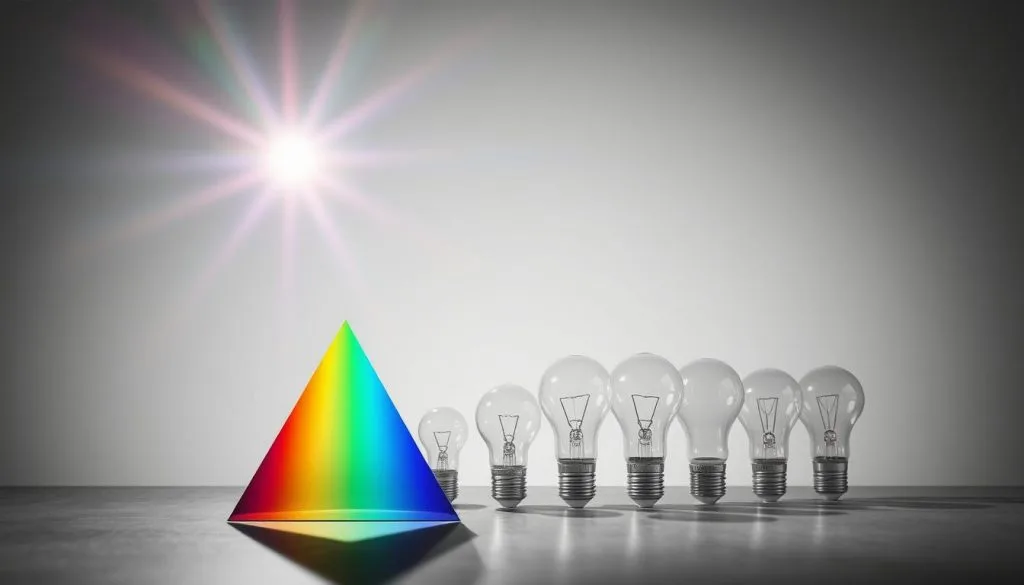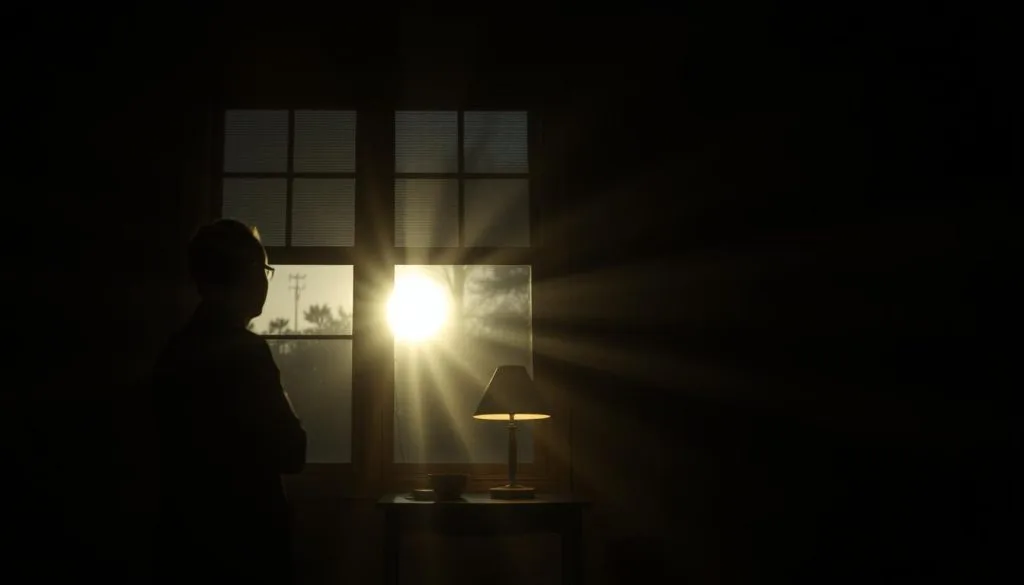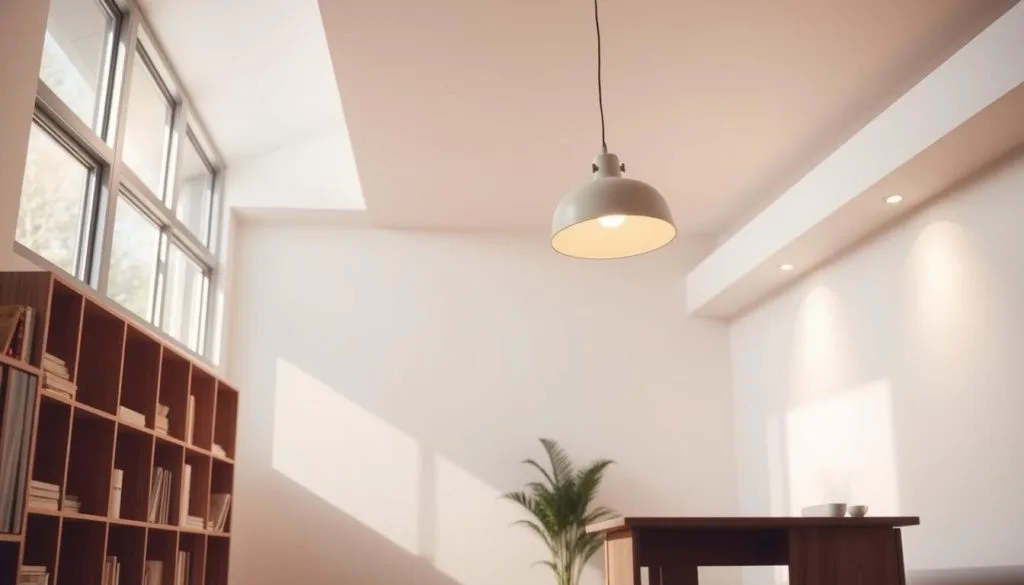This post may contains affiliate links. Read our full disclosure here.
Ever notice how a sunlit room feels like a serotonin boost? Or why your phone’s blue glow leaves you wired at midnight? Light doesn’t just brighten spaces—it rewires our biology. From circadian rhythms to workplace productivity, the battle between golden-hour rays and LED precision shapes modern life.
Nature’s glow offers no dimmer switch. Sunlight floods rooms unpredictably, painting walls with shifting shadows. Meanwhile, engineered bulbs let designers craft Instagram-worthy ambiances. But this isn’t just about aesthetics—78% of workers report better moods with window access, while screens’ blue wavelengths hijack sleep cycles.

Consider this: offices bathed in daylight slash drowsiness by 56%, per Cornell research. Yet urban jungles thrive on neon signs and smart-home systems. Can we balance raw solar power with tactical tech? Architects now play mad scientists, blending skylights with tunable LEDs to optimize both vitamin D and midnight productivity.
Modern design isn’t choosing sides—it’s hacking biology. Think circadian-friendly bulbs synced to sunrise patterns, or hospitals using wavelength-tuned fixtures to speed recovery. The future? Spaces that don’t just look good but feel alive, merging nature’s chaos with human ingenuity.
Introduction: Framing the Light Debate
How many hours do urban dwellers spend squinting at screens versus soaking in sunlight? Modern design’s tension lies in balancing organic glow with algorithmic precision. Architects and TikTok interior enthusiasts alike wrestle with this duality: raw daylight’s unpredictability versus LEDs’ surgical control.
Setting the Context for Modern Living
City apartments and open-plan offices reveal the conflict. Floor-to-ceiling windows promise connection to nature but battle glare from neighboring skyscrapers. Meanwhile, programmable artificial light systems mimic dawn in windowless gyms. A recent study found 63% of remote workers position desks near sources of natural illumination—when available.
How Light Shapes Ambiance and Health
Consider two spaces: a fluorescent-lit cubicle farm versus a sun-drenched loft. The former triggers cortisol spikes; the latter enhances serotonin production. “Light isn’t decoration—it’s biological code,” notes neuroscientist Dr. Amara Chen. Her team found hospital rooms with optimized windows reduced patient recovery times by 18%.
| Feature | Natural Light | Artificial Light | Impact |
|---|---|---|---|
| Source | Sun | LED/Tungsten | Mood regulation |
| Control | Weather-dependent | Smartphone-adjusted | Productivity metrics |
| Health Factor | Vitamin D synthesis | Circadian alignment | Sleep quality |
Forward-thinking room designs now hybridize both sources. Co-working spaces blend skylights with tunable LEDs that shift from energizing cool whites to sunset hues. The benefits? A 22% drop in afternoon fatigue reported by users.
Differences Between Natural and Artificial Light
Imagine sunlight as jazz—improvisational, dynamic, impossible to replicate. Now picture artificial lights as classical music: precise, repeatable, endlessly tweakable. This fundamental tension defines modern light sources, where organic rhythms clash with human-engineered control.

Nature’s Unscripted Performance
Sunlight delivers a full-spectrum show—visible colors plus infrared warmth and ultraviolet edge. Its intensity swings from 1,000 lux at dawn to 100,000 lux at noon, directly syncing with our circadian clocks. “This variability isn’t a bug—it’s evolution’s feature,” explains lighting designer Mara Voss. Offices bathing workers in 500+ lux daylight see 32% fewer errors in detail-oriented tasks.
Humanity’s Light Remix
Artificial lighting trades spontaneity for precision. LED panels and fluorescent tubes offer:
- Tunable color temperatures (2700K to 6500K)
- Consistent 300-500 lux workspace illumination
- Programmable schedules mirroring solar patterns
Yet most types miss sunlight’s infrared wavelengths crucial for skin health. New bioadaptive LED systems now shift from energizing blue-white mornings to amber evenings, cutting melatonin disruption by 41% in nightshift hospitals.
| Factor | Daylight | Engineered Light |
|---|---|---|
| Lux Range | 1,000-100,000 | 50-1,000 |
| Spectrum | Full (including UV/IR) | Partial |
| Best For | Mood regulation | Task focus |
The Science of Natural vs. Artificial Light in Spaces
Productivity spikes 40% under skylights. Nightshift workers gain 2.6 hours of sleep with amber LEDs. Our cells don’t care about aesthetics—they demand specific wavelengths to thrive. Modern research reveals how illumination sources act as invisible conductors of human performance.

Spectrum Wars: Full vs. Filtered
Sunlight’s rainbow contains 1,000+ nanometers—including infrared warmth and UVB rays that trigger vitamin D. Most bulbs? They’re missing 60% of that spectrum. A 2023 Johns Hopkins study found:
- Classrooms with full-spectrum LEDs improved test scores by 19%
- Warehouses using daylight-mimicking fixtures reduced energy costs by 34%
- Homes with east-facing windows reported 27% fewer seasonal depression cases
Your Internal DJ Needs the Right Beats
Circadian rhythms aren’t poetry—they’re math. Every sunrise resets cortisol/melatonin ratios like a biological metronome. Blue-rich office lighting? It’s the equivalent of blasting death metal at a yoga studio. “We’re seeing melatonin suppression start within 8 minutes of screen exposure,” warns chronobiologist Dr. Lila Marcos.
Hospital recovery wards using dawn-simulation lighting cut patient discharge times by 22%
Smart building designs now treat space illumination like prescription medicine. Daylight strategies in urban homes prioritize morning light baths, while tunable LEDs combat afternoon slumps. It’s not decor—it’s dopamine engineering.
Design Strategies for Optimizing Light in Spaces
What if your office could wake you up better than coffee? Cutting-edge design now weaponizes illumination as both productivity fuel and energy saver. Architects and engineers deploy sunlight like Spotify algorithms—curating playlists of photons for every mood and task.

Architectural Techniques: Windows, Skylights, and Light Wells
Strategic skylights act as solar DJs, mixing direct and diffused rays. Reflective ceilings bounce 80% more daylight into corners, slashing artificial levels by noon. Laboratories prove the effects: MIT’s nanoengineering hub uses prismatic glass to stretch morning light 47% deeper into workspaces.
Enhancing Productivity Through Thoughtful Lighting
Glare-free zones aren’t luxury—they’re neuroscience. Programmable LEDs shift from 6500K focus beams to 2700K chill vibes, syncing with circadian time stamps. “Workers exposed to dynamic lighting report 31% less eye strain,” notes a 2024 Steelcase ergonomics report. Bonus: motion-sensing fixtures prevent energy waste during Zoom naps.
Energy Efficiency and Modern LED Solutions
Today’s LEDs aren’t your dorm-room bulbs. Full-spectrum panels mimic solar quality while sipping 90% less juice than incandescents. Smart systems harvest daylight like crypto miners, auto-dimming when sunbeams flood the environment. The role of tech? Seattle’s Climate Pledge Arena runs entirely on skylight-powered LEDs—zero dark corners, 100% renewable swagger.
Final blueprint: blend raw sunlight’s randomness with LEDs’ surgical precision. Because the best spaces don’t just look bright—they feel alive.
Conclusion
Why do sunrise-aligned LEDs outrank caffeine in some tech offices? Modern lives demand lighting that works smarter, not harder. Research confirms what biohackers already know: balanced illumination isn’t luxury—it’s survival gear for our screen-dominated world.
Studies reveal hybrid setups boost office productivity by 31% while safeguarding sleep cycles. “The real advantage? Spaces that adapt like living organisms,” notes a MIT design lead. Morning light baths sharpen focus; evening amber tones protect melatonin levels—a one-two punch against eye strain and burnout.
Urban dwellers’ needs are clear: aesthetics that don’t sacrifice biological needs. Full-spectrum bulbs now mimic sunlight’s mood-boosting wavelengths, while smart windows auto-tint to block glare. Yet nothing replaces raw daylight’s ability to elevate Vitamin D and mental clarity.
The challenge? Treat every room like a circadian lab. Designers must merge medical-grade research with Instagram-worthy ambiance. Users? Demand fixtures that do more than look pretty. Because when your bedroom lighting doubles as sleep armor and your office LEDs fight afternoon slumps? That’s how spaces earn their keep.




